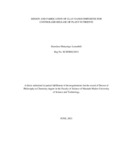| dc.contributor.author | Lusambili, Stanslaus Manyengo | |
| dc.date.accessioned | 2024-01-18T11:14:05Z | |
| dc.date.available | 2024-01-18T11:14:05Z | |
| dc.date.issued | 2021-06 | |
| dc.identifier.uri | http://ir-library.mmust.ac.ke:8080/xmlui/handle/123456789/2598 | |
| dc.description | Doctor of Philosophy in Chemistry | en_US |
| dc.description.abstract | This study was necessitated by low crop yields on farms and pollution effects of leached unused fertilizers into the environment, challenges that can be solved by nanotechnology. Clay was modified by surfactant and stabilizers into multifunctional nanocomposite material used as carriers for fertilizers. The multifunctional nanocomposites were optimized in water and in maize planted in a greenhouse. The pH of the white and black clay soils used were 6.5 and 5.3 respectively while the soil that was used in optimization had pH 7.1. The CEC of white, black and soil used in optimization was 6.0, 20.2 and 19.6 me% respectively. X-Ray Diffraction (XRD) mineralogical analysis showed that the clay soils contained; kaolinite at 16.8%, muscovite at 21.7%, illite at 55.1%, and petalite at 5.9%. The Energy Dispersive X-ray spectroscopy (EDX) results showed major compositions of SiO2 at 46.3%, Al2O3 at 29.8% and K2O at 13.7% in the clays. The percentage of sulphur in the organoclay MOC2 increased by 0.3% after intercalation. The increase in percentage potassium in SRF2 from 24.8% to 45.6% and phosphorus from nil to 21.3% confirmed dispersion of NPK fertilizer into the organoclay. Fourier Transform Infra-red (FTIR) confirmed presence of clay minerals in the raw materials and showed intercalation into multifunctional nanocomposites. Furthermore, FTIR done on starch-polyvinyl alcohol (PVA) showed that the starch and PVA had polymerized to form superabsorbent polymer (SAP). The starch-PVA had higher water absorbency of 9.03 g as compared to the other superabsorbent starch-Gum Arabic (GA) that had 4.47 g after 8 hours. Starch-PVA had a fickian factor; n of 4.95 as compared to 4.49 for starch-GA. Scanning Electron Microscopy (SEM) and Transmission Electron Microscopy (TEM) pictures showed presence surface pores and interlayers in the clay materials which were confirmed by Branauer- Emmette-Teller (BET) isotherms. Analysis of XRD data points showed shifts in d-spacings after modification into nanocomposites. Moreover the clays showed high thermal stability with Thermogravimetric Analysis (TGA) of black and white clay showing stability of up to 459.7°C and 565.9°C respectively. The rate of water absorption of SAPs and dissolution in water fitted into the pseudo first order equation while the one for sorption of nutrients into soils during optimization fitted into pseudo second order. The simulation in water showed slightly lower dissolution of nitrogen and potassium in the 70-30 formulas than the 50-50 while phosphorus showed slightly lower dissolution in the 50-50 formula than 70-30 formula. The greenhouse optimization showed that the SRF2 and CRFs released lower unused nutrients into the soils after 14 weeks of study. The study achieved conversion of clay into nanocomposite slow release fertilizer and recommends these treatments for sustainable agriculture that would also ensure conservation of soil resources through reduced leachates from excess fertilizers in soils. | en_US |
| dc.language.iso | en | en_US |
| dc.publisher | MMUST | en_US |
| dc.subject | DESIGN, FABRICATION, CLAY, NANOCOMPOSITES, PLANT NUTRIENTS | en_US |
| dc.title | DESIGN AND FABRICATION OF CLAY NANOCOMPOSITES FOR CONTROLLED RELEASE OF PLANT NUTRIENTS | en_US |
| dc.type | Thesis | en_US |

